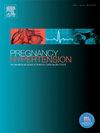Evaluation of a remote blood pressure monitoring program during pregnancy: utilization and implementation outcomes
IF 2.9
4区 医学
Q2 OBSTETRICS & GYNECOLOGY
Pregnancy Hypertension-An International Journal of Womens Cardiovascular Health
Pub Date : 2025-08-18
DOI:10.1016/j.preghy.2025.101251
引用次数: 0
Abstract
Objectives
To identify factors associated with enrollment, retention, and patient engagement in the antenatal remote blood pressure (BP) monitoring program, Connected MOM, and to evaluate program implementation by race and residence.
Study design
Retrospective cohort.
Main outcome measures
Implementation outcomes (adoption, reach, implementation, sustainability, acceptability) and rates of patient enrollment, retention and engagement.
Results
34,387 Connected MOM-eligible pregnancy episodes (29,897 unique patients) were identified between November 1, 2016 and October 1, 2023. Of those, 8,471 pregnancies (24.6 %) had no offer made by the provider; 1,371 pregnancies (4.0 %) declined participation; 7,509 pregnancies (21.8 %) had an order placed but did not sign the consent form; 6,471 pregnancies (18.8 %) consented and onboarded, but did not submit a remote BP reading required to become enrolled; and 10,565 pregnancies (30.7 %) enrolled. Of those who were offered participation, approximately 40 % of eligible patients enrolled in the program; however, White (44.3 %) and urban patients (40.0 %) were more likely to enroll than Black (35.3 %) and rural patients (24.5 %) (p < 0.0001). Program attrition was very low (1.3 %) and patients averaged at least one BP reading per week about 50 % of the weeks enrolled. Lower patient engagement was associated with Black race (p < 0.0001), rural residence (p = 0.030), and having a public insurance payer (p < 0.0001). Highly engaged patients were more likely to have highly engaged providers (RR = 1.06, 95 % CI, 1.02–1.11).
Conclusion
Identifying and addressing barriers at each step along the enrollment pathway is required for equitable implementation and improvement in maternal outcomes. Provider engagement in the program should be encouraged to improve patient engagement once enrolled.
孕期远程血压监测方案的评价:利用和实施结果
目的确定产前远程血压(BP)监测项目(Connected MOM)的入组、保留和患者参与的相关因素,并按种族和居住地评估项目的实施情况。研究设计:回顾性队列。主要结果测量实施结果(采用、覆盖、实施、可持续性、可接受性)和患者登记率、保留率和参与率。结果2016年11月1日至2023年10月1日,共发现34,387例符合准妈妈妊娠期(29,897例独特患者)。其中,8471例怀孕(24.6%)没有得到提供者的建议;1371名孕妇(4.0%)的参与率下降;7509名孕妇(21.8%)已下单,但未签署同意书;6471名孕妇(18.8%)同意并入组,但未提交入组所需的远程血压读数;10565名孕妇(30.7%)登记。在那些被邀请参与的患者中,大约40%的符合条件的患者参加了该计划;然而,白人(44.3%)和城市患者(40.0%)比黑人(35.3%)和农村患者(24.5%)更有可能入组(p < 0.0001)。项目损耗非常低(1.3%),患者平均每周至少一次血压读数,约占入组周的50%。较低的患者参与度与黑人种族(p < 0.0001)、农村居住(p = 0.030)和拥有公共保险支付者(p < 0.0001)有关。高度敬业的患者更有可能拥有高度敬业的医护人员(RR = 1.06, 95% CI, 1.02-1.11)。结论要公平实施和改善孕产妇结局,需要识别和解决注册路径中每个步骤的障碍。应鼓励提供者参与该计划,以提高患者参与的程度。
本文章由计算机程序翻译,如有差异,请以英文原文为准。
求助全文
约1分钟内获得全文
求助全文
来源期刊

Pregnancy Hypertension-An International Journal of Womens Cardiovascular Health
OBSTETRICS & GYNECOLOGYPERIPHERAL VASCULAR-PERIPHERAL VASCULAR DISEASE
CiteScore
4.90
自引率
0.00%
发文量
127
期刊介绍:
Pregnancy Hypertension: An International Journal of Women''s Cardiovascular Health aims to stimulate research in the field of hypertension in pregnancy, disseminate the useful results of such research, and advance education in the field.
We publish articles pertaining to human and animal blood pressure during gestation, hypertension during gestation including physiology of circulatory control, pathophysiology, methodology, therapy or any other material relevant to the relationship between elevated blood pressure and pregnancy. The subtitle reflects the wider aspects of studying hypertension in pregnancy thus we also publish articles on in utero programming, nutrition, long term effects of hypertension in pregnancy on cardiovascular health and other research that helps our understanding of the etiology or consequences of hypertension in pregnancy. Case reports are not published unless of exceptional/outstanding importance to the field.
 求助内容:
求助内容: 应助结果提醒方式:
应助结果提醒方式:


